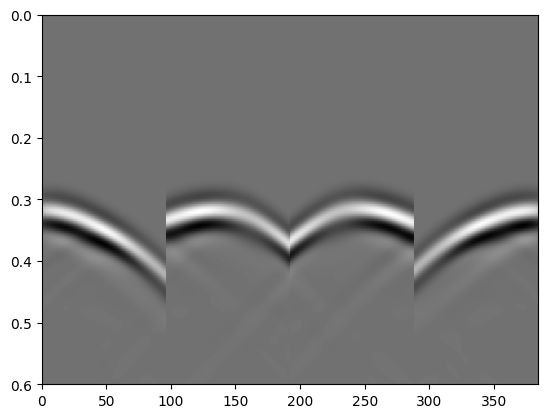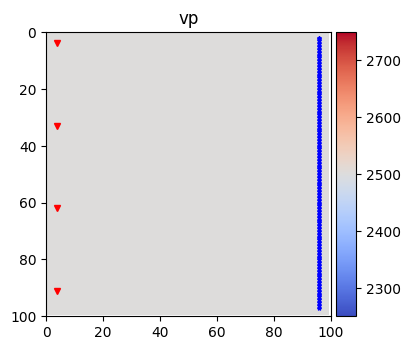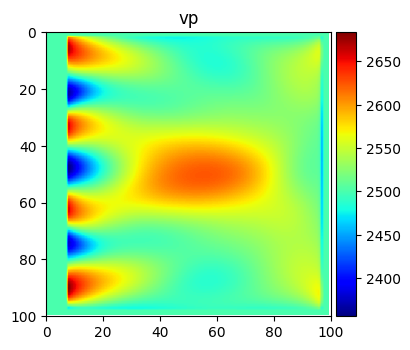Simple FWI Example
In this section we see application of PyFWI for performin FWI. First, forward modeling is shown and then we estimate a model of subsurface using FWI.
1. Forward modeling
In this simple example, we use PyFWI to do forward modeling. So, we need to first import the following packages amd modulus.
import matplotlib.pyplot as plt
import numpy as np
import PyFWI.wave_propagation as wave
import PyFWI.acquisition as acq
import PyFWI.seiplot as splt
import PyFWI.model_dataset as md
import PyFWI.fwi_tools as tools
import PyFWI.processing as process
from PyFWI.fwi import FWI
A simple model can be created by using model_dataset module as
Model = md.ModelGenerator('louboutin')
model = Model()
im = splt.earth_model(model, cmap='coolwarm')

Then we need to create an input dictionary as follow
model_shape = model[[*model][0]].shape
inpa = {
'ns': 4, # Number of sources
'sdo': 4, # Order of FD
'fdom': 15, # Central frequency of source
'dh': 7, # Spatial sampling rate
'dt': 0.004, # Temporal sampling rate
'acq_type': 0, # Type of acquisition (0: crosswell, 1: surface, 2: both)
't': 0.6, # Length of operation
'npml': 20, # Number of PML
'pmlR': 1e-5, # Coefficient for PML (No need to change)
'pml_dir': 2, # type of boundary layer
'device': 1, # The device to run the program. Usually 0: CPU 1: GPU
}
seisout = 0 # Type of output 0: Pressure
inpa['rec_dis'] = 1 * inpa['dh'] # Define the receivers' distance
Now, we obtain the location of sources and receivers based on specified parameters.
offsetx = inpa['dh'] * model_shape[1]
depth = inpa['dh'] * model_shape[0]
src_loc, rec_loc, n_surface_rec, n_well_rec = acq.acq_parameters(inpa['ns'],
inpa['rec_dis'],
offsetx,
depth,
inpa['dh'],
inpa['sdo'],
acq_type=inpa['acq_type'])
# src_loc[:, 1] -= 5 * inpa['dh']
# Create the source
src = acq.Source(src_loc, inpa['dh'], inpa['dt'])
src.Ricker(inpa['fdom'])
Finally, we can have the forward modelling as
# Create the wave object
W = wave.WavePropagator(inpa, src, rec_loc, model_shape,
n_well_rec=n_well_rec,
components=seisout, chpr=0)
# Call the forward modelling
d_obs = W.forward_modeling(model, show=False) # show=True can show the propagation of the wave
plt.imshow(d_obs["taux"], cmap='gray',
aspect="auto", extent=[0, d_obs["taux"].shape[1], inpa['t'], 0])
<matplotlib.image.AxesImage at 0x15144c760>

2. FWI
To perform FWI, we need the observed data and an initial model.
Note: For better visualization and avoiding crosstalk, I compute the gradient in acoustic media.
Here is a homogeneous initial model.
m0 = Model(smoothing=1)
m0['vs'] *= 0.0
m0['rho'] = np.ones_like(model['rho'])
fig = splt.earth_model(m0, ['vp'], cmap='coolwarm')
fig.axes[0].plot(src_loc[:,0]//inpa["dh"],
src_loc[:,1]//inpa["dh"], "rv", markersize=5)
fig.axes[0].plot(rec_loc[:,0]//inpa["dh"],
rec_loc[:,1]//inpa["dh"], "b*", markersize=3)
[<matplotlib.lines.Line2D at 0x158434ee0>]

Now, we can create a FWI object,
fwi = FWI(d_obs, inpa, src, rec_loc, model_shape,
components=seisout, chpr=20, n_well_rec=n_well_rec)
and call it by providing the initial model m0, observed data
d_obs, optimization method method, desired frequencies for
inversion, number of iterations for each frequency, number of parameters
for inversion n_params, index of the first parameter k_0, and
index of the last parameter k_end. For example, if we have an
elastic model, but we want to only invert for P-wave velocity, these
parameters should be defined as
n_params = 1
k_0 = 1
k_end = 2
If we want to invert for P-wave velocity and then \(V_S\), these parameters should be defined as
n_params = 1
k_0 = 1
k_end = 3
and for simultaneously inverting for these two parameters, we define these parameters as
n_params = 2
k_0 = 1
k_end = 3
m_est, _ = fwi(m0, method="lbfgs",
freqs=[25, 45], iter=[2, 2],
n_params=1, k_0=1, k_end=2)
Parameter number 1 to 1
2500.0 2500.0
for f= 25: rms is: 0.0003187612455803901 with rms_reg: 0, and rms_data: 0.0003187612455803901, rms_mp: 0.0, rms_model_relation: 0
Parameter number 1 to 1
RUNNING THE L-BFGS-B CODE
* * *
Machine precision = 2.220D-16
N = 10000 M = 10
At X0 0 variables are exactly at the bounds
At iterate 0 f= 3.18761D-04 |proj g|= 7.19684D-10
* * *
Tit = total number of iterations
Tnf = total number of function evaluations
Tnint = total number of segments explored during Cauchy searches
Skip = number of BFGS updates skipped
Nact = number of active bounds at final generalized Cauchy point
Projg = norm of the final projected gradient
F = final function value
* * *
N Tit Tnf Tnint Skip Nact Projg F
10000 0 1 0 0 0 7.197D-10 3.188D-04
F = 3.1876124558039010E-004
CONVERGENCE: NORM_OF_PROJECTED_GRADIENT_<=_PGTOL
This problem is unconstrained.
2500.0 2500.0
for f= 45: rms is: 0.004415073432028294 with rms_reg: 0, and rms_data: 0.004415073432028294, rms_mp: 0.0, rms_model_relation: 0
RUNNING THE L-BFGS-B CODE
* * *
Machine precision = 2.220D-16
N = 10000 M = 10
At X0 0 variables are exactly at the bounds
At iterate 0 f= 4.41507D-03 |proj g|= 2.39370D-08
ITERATION 1
---------------- CAUCHY entered-------------------
There are 0 breakpoints
GCP found in this segment
Piece 1 --f1, f2 at start point -6.4549D-13 6.4549D-13
Distance to the stationary point = 1.0000D+00
---------------- exit CAUCHY----------------------
10000 variables are free at GCP 1
This problem is unconstrained.
2499.9827111341883 2500.0297937900996
for f= 45: rms is: 0.004414360038936138 with rms_reg: 0, and rms_data: 0.004414360038936138, rms_mp: 0.0, rms_model_relation: 0
2499.9135556709416 2500.1489689504983
for f= 45: rms is: 0.004411510191857815 with rms_reg: 0, and rms_data: 0.004411510191857815, rms_mp: 0.0, rms_model_relation: 0
2499.636933817955 2500.6256695920933
for f= 45: rms is: 0.004400133620947599 with rms_reg: 0, and rms_data: 0.004400133620947599, rms_mp: 0.0, rms_model_relation: 0
2498.530446406008 2502.5324721584725
for f= 45: rms is: 0.00435509392991662 with rms_reg: 0, and rms_data: 0.00435509392991662, rms_mp: 0.0, rms_model_relation: 0
2494.1044967582216 2510.1596824239887
for f= 45: rms is: 0.004182371310889721 with rms_reg: 0, and rms_data: 0.004182371310889721, rms_mp: 0.0, rms_model_relation: 0
2476.400698167074 2540.668523486055
for f= 45: rms is: 0.003607903141528368 with rms_reg: 0, and rms_data: 0.003607903141528368, rms_mp: 0.0, rms_model_relation: 0
LINE SEARCH 5 times; norm of step = 1365.0000000000000
At iterate 1 f= 3.60790D-03 |proj g|= 1.91296D-08
ITERATION 2
----------------SUBSM entered-----------------
----------------exit SUBSM --------------------
2356.1934399025804 2683.887118020453
for f= 45: rms is: 0.0026031285524368286 with rms_reg: 0, and rms_data: 0.0026031285524368286, rms_mp: 0.0, rms_model_relation: 0
LINE SEARCH 0 times; norm of step = 3577.6768283163833
At iterate 2 f= 2.60313D-03 |proj g|= 1.26216D-08
* * *
Tit = total number of iterations
Tnf = total number of function evaluations
Tnint = total number of segments explored during Cauchy searches
Skip = number of BFGS updates skipped
Nact = number of active bounds at final generalized Cauchy point
Projg = norm of the final projected gradient
F = final function value
* * *
N Tit Tnf Tnint Skip Nact Projg F
10000 2 8 1 0 0 1.262D-08 2.603D-03
F = 2.6031285524368286E-003
STOP: TOTAL NO. of ITERATIONS REACHED LIMIT
Here is the estimated model
# Time to plot the results
fig = splt.earth_model(m_est, ['vp'], cmap='jet')
